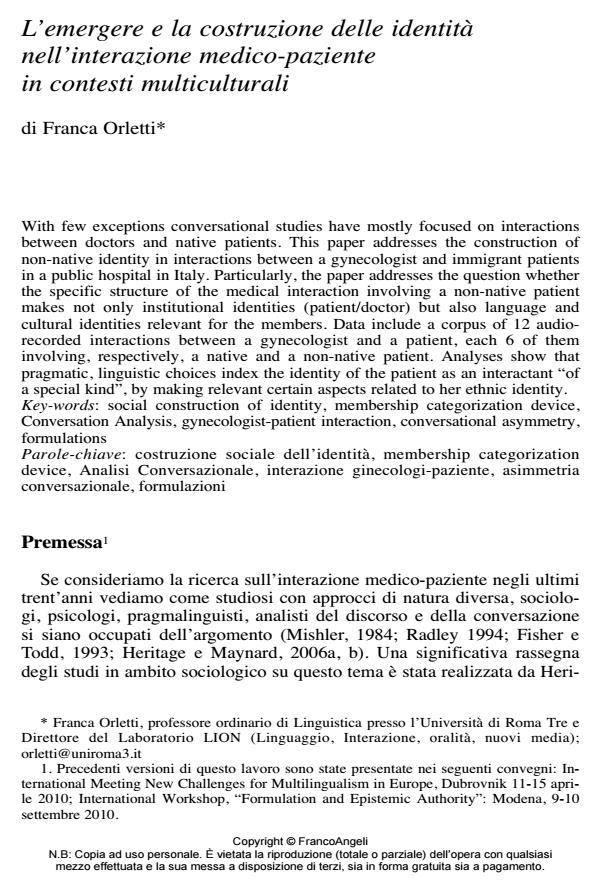L’emergere e la costruzione delle identità nell’interazione medico-paziente in contesti multiculturali
Titolo Rivista SALUTE E SOCIETÀ
Autori/Curatori Franca Orletti
Anno di pubblicazione 2013 Fascicolo 2013/1
Lingua Italiano Numero pagine 15 P. 61-75 Dimensione file 119 KB
DOI 10.3280/SES2013-001006
Il DOI è il codice a barre della proprietà intellettuale: per saperne di più
clicca qui
Qui sotto puoi vedere in anteprima la prima pagina di questo articolo.
Se questo articolo ti interessa, lo puoi acquistare (e scaricare in formato pdf) seguendo le facili indicazioni per acquistare il download credit. Acquista Download Credits per scaricare questo Articolo in formato PDF

FrancoAngeli è membro della Publishers International Linking Association, Inc (PILA)associazione indipendente e non profit per facilitare (attraverso i servizi tecnologici implementati da CrossRef.org) l’accesso degli studiosi ai contenuti digitali nelle pubblicazioni professionali e scientifiche
With few exceptions conversational studies have mostly focused on interactions between doctors and native patients. This paper addresses the construction of non-native identity in interactions between a gynecologist and immigrant patients in a public hospital in Italy. Particularly, the paper addresses the question whether the specific structure of the medical interaction involving a non-native patient makes not only institutional identities (patient/doctor) but also language and cultural identities relevant for the members. Data include a corpus of 12 audiorecorded interactions between a gynecologist and a patient, each 6 of them involving, respectively, a native and a non-native patient. Analyses show that pragmatic, linguistic choices index the identity of the patient as an interactant "of a special kind", by making relevant certain aspects related to her ethnic identity.
Parole chiave:Costruzione sociale dell’identità, membership categorization device, Analisi Conversazionale, interazione ginecologi-paziente, asimmetria conversazionale, formulazioni
- (Re)transmettre la souffrance émotionnelle : une analyse interactionnelle de consultations entre soignants, demandeurs d’asile et interprètes en France Vanessa Piccoli, in Langage et société /2019 pp.175
DOI: 10.3917/ls.167.0175 - The agency of language in institutional talk Letizia Caronia, Franca Orletti, in Language and Dialogue /2019 pp.1
DOI: 10.1075/ld.00029.orl - Chinese Interpreting Sabrina Ardizzoni, pp.335 (ISBN:978-3-031-66366-6)
- Interculturality in Institutions Marilena Fatigante, Cristina Zucchermaglio, Francesca Alby, pp.161 (ISBN:978-3-031-12625-3)
- ‘We will take care of you’: Identity categorisation markers in intercultural medical encounters Valentina Fantasia, Cristina Zucchermaglio, Marilena Fatigante, Francesca Alby, in Discourse Studies /2021 pp.451
DOI: 10.1177/14614456211009060
Franca Orletti, L’emergere e la costruzione delle identità nell’interazione medico-paziente in contesti multiculturali in "SALUTE E SOCIETÀ" 1/2013, pp 61-75, DOI: 10.3280/SES2013-001006